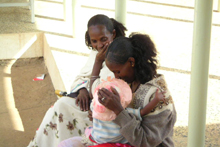
Model Families to Model Country: Community Workers Help Scale Up Ethiopia’s Health Program
- Login to post comments
-

 In a typical farmhouse scenario, families live in single-room homes—made of straw, wood, and mud—together with their cattle and other animals. They cook in the same room and do not have latrines or isolated waste disposal facilities. However, Ethiopia’s “model families”—a cornerstone of the country’s successful Health Extension Program (HEP)—build separate kitchens, arrange a place for their cattle outside the family tukul, and dig latrines.
In a typical farmhouse scenario, families live in single-room homes—made of straw, wood, and mud—together with their cattle and other animals. They cook in the same room and do not have latrines or isolated waste disposal facilities. However, Ethiopia’s “model families”—a cornerstone of the country’s successful Health Extension Program (HEP)—build separate kitchens, arrange a place for their cattle outside the family tukul, and dig latrines.
Empowering families with healthy behaviors
Training model families is one of the HEP’s important strategies, and is adapted from Paul Lazarsfeld’s and Everett Rogers’ theories of mass communication and diffusion of innovation. Using criteria based on social and economic status with the community, the HEP selects women who are likely to be early adopters of new behaviors as health extension workers (HEWs). The HEWs train parents on health behaviors such as hygiene and sanitation, accessing services (e.g., early childhood immunization), family planning, infant feeding practices, and nutrition. The family uses these lessons to make changes to its home and health care, and then it can graduate and become a model family. Scaling up
Scaling up
The HEP began in 2004 and there are now 34,000 HEWs in Ethiopia. The HEP initially focused on establishing model families in rural areas, and in recent years has included urban settings as well. It has also grown in scope by increasing the target for training of model families to cover 100% of Ethiopian households. As the Ethiopian minister of health noted at the recent Global Health Council meeting, “Delivering impact in women and children’s health: The challenges and opportunities of service integration,” the principle aims at a continuous expansion of model families to model villages-districts-provinces, and then eventually to a model country!
Making an impact
Currently, HEWs provide an expanded array of primary health care services that include rapid diagnostic testing and treatment of malaria, insertion of single-rod implants for women seeking long-term family planning methods, clean and safe child delivery, administration of misoprostol for women to prevent postpartum hemorrhage, and community case management of pneumonia.
The HEP is also credited with marked improvements in several health indicators. Comparing some of the indicators from the Ethiopia demographic and health survey 2005 to the Baseline household health survey summary report in 2009 we see that:
- Contraceptive prevalence increased from 14.7% to 31.6%
- The proportion of children fully immunized grew from 16.7% to 46.3%
- Antenatal care coverage increased from 28% to 54%
- Households with mosquito nets increased from 6% to 75%.
According to the minister of health, the forthcoming demographic and health survey for 2011 will show even more improvements.
Beyond Ethiopia’s borders
CapacityPlus explores available global interventions that help enhance the productivity of community health workers, particularly in a well-integrated community health program. Recognizing the importance of bringing health services closer to the community at scale, CapacityPlus plans to engage further as more countries (i.e., Mali, Mozambique) adopt similar strategies and determine key guiding principles for a successful community health program both at policy and service delivery points.
Related items:
Photo 1 by Crystal Ng. Photo 2 courtesy of IntraHealth International. (Ethiopian women, Tigray, Ethiopia)


